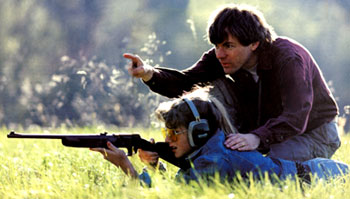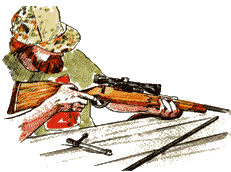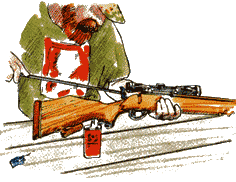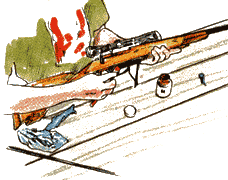Safe Shooting
Starting out right with recreational firearms
By Tom Gresham
When guns and shooting are mentioned, certain images spring to mind. For many Americans, especially those who live away from the land-starved megamesses we call cities, the images are of recreation, competition, personal challenges and family fun. Unseen and unreported by the mass media, millions of people enjoy guns and shoot billions of rounds of ammunition every year in complete safety. And they do it primarily for one reason—shooting is one heck of a lot of fun!
Shooting is traditionally taught by fathers. Many women shoot, but it seems fair to say that in most cases the teaching is done by the menfolk. If your father didn't teach you to shoot, you might be frightened by the thought of learning by yourself. After all, you don't know anything about it and you might do something stupid, or worse. I mean, guns are dangerous, right?
Before you have an anxiety attack, though, take some time to consider just how dangerous guns are, or are not. Put a firearm on the table, don't let anyone touch it for 100 years, and I guarantee it will do nothing but slowly rust. Guns don't do anything by themselves. The plain fact is that firearms are not dangerous when handled and stored properly. Same as a car, right? You wouldn't presume to be able to drive a car safely if you had never been taught, so don't expect to be able to shoot well or handle a gun safely without instruction and practice.
Fortunately, help is nearby. No matter where you live, there are surely shooters in your area. And as is the case with people avid in any sport, most shooters like to bring others into the fold. Talk with your neighbors. If you live out of the city, you'll find that some of them have guns and like to shoot. Your best bet is a local shooting range or gun club. That's where you get quality instruction and a ready source of answers for all the questions you'll have.
No shooting range nearby? Call the police. Someone on the force or in the sheriffs department will be able to teach you. Even if it's not a formal class, just ask if anyone can spare enough time to show you the basics. It's pretty unlikely you'll strike out.
Perhaps you do have some experience with guns. Now you want to teach your family to shoot. How old should children be before you start them oft? Some are ready at six, and some still aren't ready at 16. Chances are you'll know when the time comes. First thing, a child must be ready to obey. Gun safety is not a matter to be approached democratically. Instructions must be followed exactly, and immediately. At about age six many children are able to handle the smallest air rifles (BB guns, if you will). Of course, they should not be allowed to shoot without direct adult supervision. That means an adult standing right beside them.
Whether you're teaching someone in your family, or you're receiving instruction and practicing on your own, you must develop safe gun-handling habits. Just as you do with everything else, you will develop habits in your gun handling. The goal is to start out with safe practices and never deviate from them. Shooting accidents are completely preventable, and a constant awareness of and adherence to accepted safe gun-handling practices are the keys. You must develop an automatic and pervasive attitude of safety.
There are several basic safety rules in handling guns, but we'll stress only a couple here. The first and most important one is this: Never point a gun at anything you aren't willing to shoot. Simple? Yes. Effective? Undoubtedly. Easy? No doubt about it. The corollary to this is to never let anyone point a gun at you. Not for an instant. If everyone followed this basic rule, even if a gun were to fire unexpectedly, it would be frightening and embarrassing, but not tragic.
The other rule to keep in mind, and it really just reinforces the first, is to treat every gun as if it's loaded. That way, you'll never find yourself thinking "It's OK, it's not loaded." That phrase has too often preceded tragedy.
With your developing attitude of safety firmly in place, it's time to select a gun. Your choice depends on several factors: intended use, experience of shooters, space available for shooting and cost. With hundreds of models in varying size, caliber, gauge and configuration, the task is to pick one that is right for you.
The first gun for many of us was the air rifle, and it might be the right gun for your purposes. Available models shoot BBs or pellets, and power comes from a spring, compressed air or a cartridge of carbon dioxide. You can find an air rifle to fit anyone from about age six and up. And the adult air rifles are excellent tools. In fact, there's an air rifle competition in the Olympics, and the guns used there may be the most sophisticated and the most accurate rifles in the world. If you want to shoot targets, knock over tin cans and just have fun, an air rifle is a good choice. Advantages include no recoil (kick), no noise, the option to shoot almost anywhere without the need for wide open spaces (even indoors), and inexpensive ammunition, which allows lots of practice.
Next up the line in terms of power and utility is the .22 rimfire rifle. This is the best choice for a first firearm for many people. There's no noticeable kick, it can be extremely accurate, ammunition is inexpensive, its greater range lets you hit targets 100 yards away (though that's a long shot), and, properly cared for, it will last forever.
Safety check: Don't let yourself think "It's only a .22." The ammunition you'll probably be shooting is called .22 Long Rifle. It has an extreme range of a mile and a half. It will kill. Be careful with it and you'll find your .22 a delight to shoot.
Several types of rifle actions are popular: single shot, bolt action, pump and autoloading. Leave the autoloaders for later, when you're quite comfortable with guns. A bolt action or single shot rifle is perfect, and there are a number of them on the market.
An innovative approach to the question of how to fit everyone with a single gun has been put forward by Daisy, the BB gun people. A new .22 rifle from Daisy has an adjustable stock which will fit youngsters, petite women and full-size adults. If the public responds well to this new rifle, you can expect to see other gun makers offering this feature.
If your interest runs to wing shooting, you'll need a shotgun. The 10-gauge and 12gauge shotguns are too heavy for many beginners, and the big shotshells kick too much to make them ideal for learning. Get a double-barreled 20-gauge shotgun, pump or autoloading action. You might hear someone advise using a .410-gauge shotgun because of the reduced recoil. Forget it. The .410 is an expert's gun because the shotshell contains so few pellets. When you can hit targets consistently with a 20-gauge, then try the .410.
Again, some basic instruction will go a long way. The shotgun is used to shoot flying targets, and throwing clay pigeons for each other is a wonderful way to spend an afternoon.
You can throw the pigeons with a hand thrower, available at almost any gun store, or you can opt for the small, spring-powered "trap." For learning, the trap (Trius is the standard brand) is better because you can send the target flying on the same course each time, allowing the "student" to concentrate on shooting, not on finding the target.
Now you have your gun and you're ready to go. Well, not quite. There are two pieces of protective equipment you need. Don't shoot without wearing shooting glasses and hearing protection. Just don't do it. The glasses protect you from tiny flecks of unburned gunpowder which might fly back at you. They also protect your eyes should there be an accident. Some very experienced shooters have had accidents caused by getting an obstruction (mud is the most common) stuck in the barrel. When fired in that condition, it's possible that a gun could burst the barrel. Very unlikely, but wear glasses just in case. Prescription eyeglasses with tempered lenses work fine.
With your eyes covered, you now need to protect your ears. Guns are loud, and repeated exposure to the noise of gunfire will permanently damage your hearing. Earmuffs for shooting look like the big-style stereo headphones without the wires. They work great. If you need to protect several pairs of ears, though (remember, everyone near the shooter needs ear protection, too), you might opt for inexpensive foam earplugs. They cost about a dollar a pair and can be used many times. Any gun store will have them.
1. Make sure the firearm isn't loaded. Do this even though you clearly remember unloading it! 3. Run dry patches down the bore until they come out clean. Follow with a lightly oiled patch.
2. Dip the cleaning rod's brush in solven, and then run it through the barrel several times. 4. Clean exterior and working parts with brush and solven, then wipe all metal with a lightly oiled cloth.
Before you begin shooting, you also need to do something that's going to sound stupid. You need to see if you should shoot righthanded or left-handed. That's determined by your master eye.
Master eye? Almost everyone has one eye that is dominant. It's the one you usually use in looking through a telescope. If you are right-handed and left-eyed (as is the author), you should be shooting left-handed. You can find out by taking this quick test.
With both arms outstretched, bring your hands together, thumbs down and palms out, making a hole by touching your thumbs and index fingers. Close up the hole until it's about the size of a quarter. Keep both eyes open and sight through the hole at someone. That person will see your master eye through the hole. If your left eye is the master eye, you should shoot left-handed. The right eye means you shoot from the right shoulder. Don't fight this! It's important that you learn to shoot with both eyes open, and you can't do that unless you sight with your dominant eye.
When you head out to find a place to shoot, keep safety firmly in mind. If you aren't going to use an established shooting range, make sure you have a safe backstop. That means you can see where the bullets are hitting behind the target. A hill or pushed-up berm of dirt is perfect. Remember that bullets can ricochet off flat surfaces—that includes dirt and water. Put your targets right in front of the backstop to ensure your bullets stop in the dirt.
Start with the target at close range. Ten feet is about right. The object is to make it easy. Nothing breeds success like success.
What kind of targets? You can buy printed bull's eye targets, and you'll want to have some of them to "record" your successes, but tin cans, big ones, are hard to beat for just plinking—fun shooting. Be sure to pick them up after you're finished.
You're going to put the targets up close and use big targets so you can hit them. You also should shoot from a position that helps you hit the target.
Holding a rifle puts you in an unnatural position which strains your arm, shoulder and back muscles. Straining muscles quiver, so shooting from a standing position is the least steady method. Begin shooting from the prone, or lying, position. For right-handed shooters, lie facing the target with your body angling out slightly to the left. Spread your legs slightly so you feel comfortable and steady. Your right hand will grab the stock near the trigger; your left will be farther forward, holding the rifle. Make sure your left elbow is directly under the stock so the gun weight pushes straight down on your arm.
A lot of folks are happy just shooting cans and targets behind the farmhouse, but others heed the call to compete. There are a number of different types of matches available for you. Again, the local gun club is the place to start.
It won't take long for you to realize that shooting is a mental game. You must be in adequate physical condition, but matches are won by those with self-discipline and those who can concentrate fiercely. Jim Clark, a national pistol champion, put it this way, "The most important six inches in shooting is between your ears."
You can, of course, compete seriously—going all the way to the Olympics—or just for fun. Local matches will teach you a lot about shooting and will be the perfect place to meet others with similar interests. Then again, you can stage informal shooting contests almost anywhere.
For an exciting informal shoot, tape a round piece of cardboard to an old tire and have someone roll it down a hill (make sure the person gets back behind the hill and that your bullets go into a safe backstop). As the tire builds speed and bounces as it rolls, hitting that cardboard will be all the challenge you'll want.
Another game is to let a breeze blow balloons along the ground while you try to pop them.
For many, owning a gun means hunting. You should match the weapon to the game being hunted. Check the local regulations for restrictions on gauges and calibers for various game animals. Many books offer advice and instruction on hunting, and every state has hunter safety instructors who can help. Call the state game department.
Another reason for owning a gun is protection. Whether you are protecting your livestock from four-legged varmints or yourself and your family from the two-legged kind, owning a gun for protection is a personal choice you should consider carefully. If you do decide to take this step, there's probably no better choice than the doublebarreled shotgun. It's relatively easy to shoot well. While lethal at close range, when loaded with bird shot it will cause pain but usually not kill at distances past 30 yards. You can also store it unloaded, yet slip two shotshells into the barrels quickly should the need arise.
Most people own guns simply because they enjoy shooting. It's a safe sport that can be enjoyed by anyone. If you've considered taking up shooting, or if you've thought about teaching your family to shoot, go ahead. More than likely you'll find it to be more fun than you imagined.
Tom Gresham has been shooting since his father, Grits, taught him at the age of five. He is the editor of Rifle and Handloader magazines in Prescott, Arizona.

Introduction and practice with a safety conscious instructor, will develop responsible and enthusiastic shooters.
| KEEP IT CLEAN
|  | 1. Make sure the firearm isn't loaded. Do this even though you clearly remember unloading it!
|  | 2. Dip the cleaning rod's brush in solven, and then run it through the barrel several times.
|  | 3. Run dry patches down the bore until they come out clean. Follow with a lightly oiled patch.
|  | 4. Clean exterior and working parts with brush and solven, then wipe all metal with a lightly oiled cloth.
|
SIDEBAR: A Secure Gun is a Safe Gun
A common concern of those thinking of buying a first gun is safe storage, particularly if there are children in the house. It's an important consideration.
Children have an unbelievable ability to find what you've hidden, so don't hide your guns. That's not a safe way to prevent children from getting them. Instead, if the children are old enough to accept instructions, explain that the guns are not to be touched, ever, without your permission. With some children, that would be enough. You may, however, want to take other steps to prevent anyone from being able to get access to your guns, or to render the guns inoperable.
Of course, you won't keep loaded guns in the house. Even a gun kept for defense can be loaded quickly, if necessary.
A number of companies make trigger locks that block the trigger completely. The lock can be removed only with a key. This certainly is an effective way to prevent accidents.
You also can buy a gun safe. This is exactly what it sounds like—a very heavy steel chest, upright or chest type, that holds a number of guns, as well as other valuables. Safes are expensive, but might be worth the price in peace of mind. Of course, a gun safe also protects your firearms from theft. Check your gun store for trigger locks and gun safes.
A simple way to prevent someone from accidentally firing your gun is to keep it disassembled, with the parts stored in separate locations. This is effective and costs nothing.
Shooting and gun ownership bring with them a responsibility. Not only must you handle your gun safely when you are shooting, but you must store it safely. Give it some thought, and you'll find the method that's right for your situation.
| 



